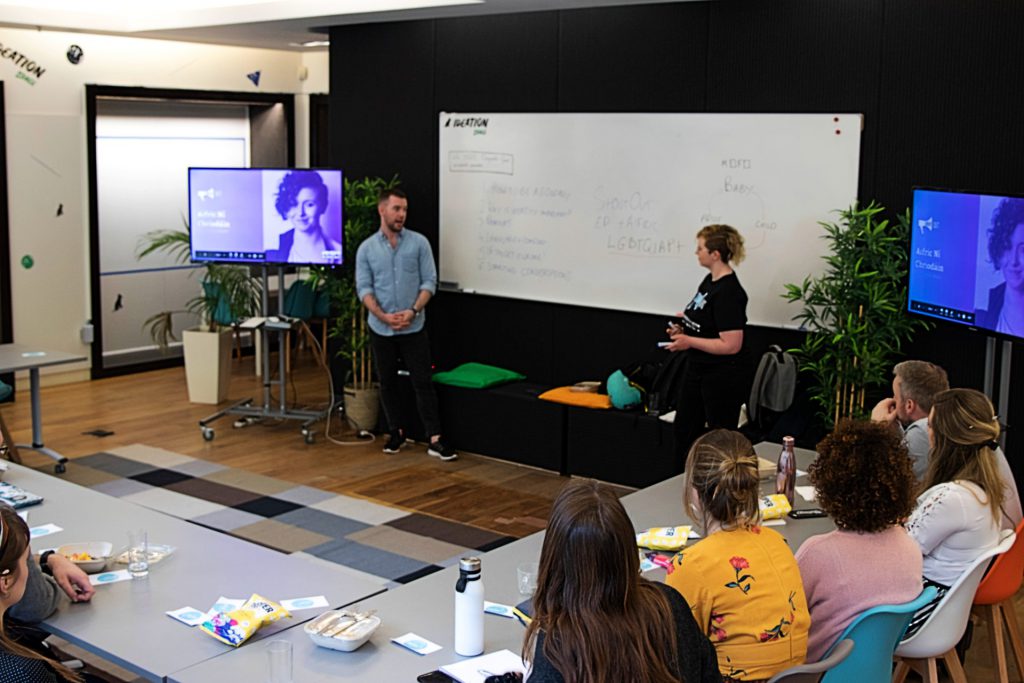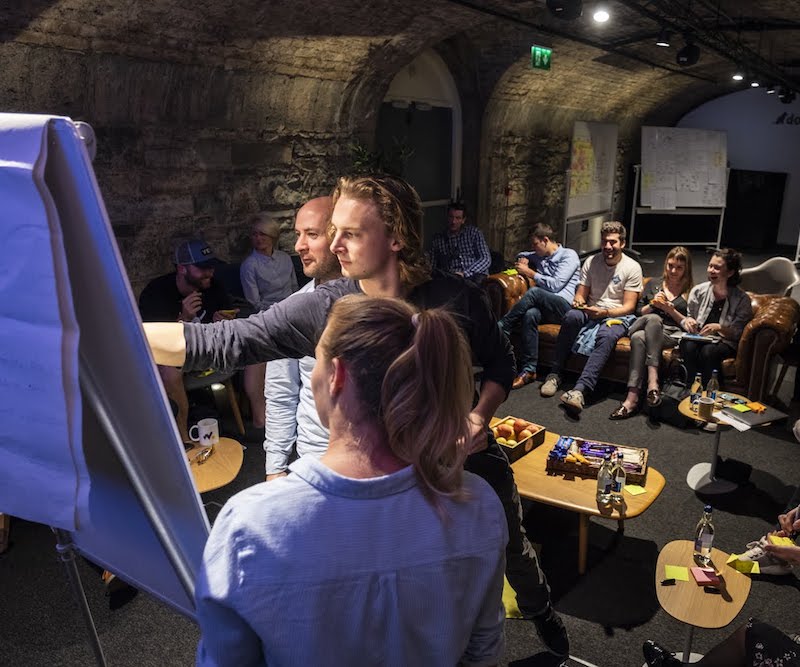“Inclusive culture is about more than just being a ‘fun-place-to-work’, it’s about nurturing the talent in each team member to help them feel supported and to excel in the careers”
– Jennifer Barret
Events Manager & Team Culture Lead
Fostering an Inclusive Environment in Your Team
Inclusion comes from valuing varied opinions and individual contributions equally, so it’s equally important to practice what you preach by implementing inclusive behaviour within your team.
On this page you’ll find:
Inclusive Management
Leading by example sets a tone for the inclusive culture you’re trying to achieve.
A key challenge for D&I in the workplace is the breadth of experiences to consider. Our social identities overlap and intersect in dynamic ways, making it difficult to practically balance them.
In becoming more conscious of your behaviour as a leader you can help neutralise biased norms within your team.
How could you compare the experience of a limited mobility female to a person of colour who identifies as queer?
Does one experience outweigh the other?
Rather than trying to compensate for these subtle differences, you can work towards cultivating a working environment that equally values and welcomes each employees perspective and seeks to nurture their potential.
Of course, that doesn’t mean dismissing unconscious bias. As a manager or team member, you should put checks and balances in place to ensure that you are assessing everyone in your team fairly and recognising the unique contribution they make. Metrics, regular check-in and
Start with Leadership Structures
Use this toolkit to develop inclusive leadership structures and strategies.
Note: The change catalyst site requires your name, company name and email before you can access this asset in full.
Actively Listen and Mediate
Watch this short clip to understand the 4 challenges multicultural teams face and the 4 strategies you can use to overcome them.
Some other tips we use are:
- Amplify communication from underrepresented minorities, and timid team members
- Give credit to idea originators
- a small acknowledgement goes a long way
- Don’t interrupt when someone else is speaking
- And don’t let anyone else interrupt either, this includes leaders that might be tempted to speak over their subordinates).
- It’s good practice to acknowledge the person who was interrupted and ask them to finish their sentence.
- Body language, tone, and eye contact contribute to people’s sense of belonging.
- Address everyone in equal measure and be aware of your own tendencies to favour those who meet your gaze over those who don’t.
- Make a conscious effort to address quieter individuals by asking for contributions from specific individuals. This effort can be the difference between further isolation or inclusion.
- It’s better not to force some to address a group it their not comfortable doing so. Instead, address them one on one.
- Use inclusive language (check out the Communications Section for more detail)
Understand Cultural Competence
Create opportunities to elevate the levels of cultural competence amongst your team. Consider whether your team understands and appreciates the differences between individuals and their style of working.
An example of a framework that helps you identify differences in behavioural and communication styles that are observed across cultures Lewis Model of Dimensions of Behaviour.
Disability cultural competence is another dimension to consider, does your team know what behaviours/responses are appropriate when dealing with someone with limited mobility?
Review The Criteria You Use To Make Judgements
Make sure you are aware of what guides your own behaviour and leadership style within your hub team.
Belbin’s Team Inventory Model is a useful framework for noting individual team members’ strengths and allowable weaknesses in an objective way. Remember this is only a guiding paradigm and everyone has a combination of these traits.
- Education
- Professional Experience
- Past Work Environments
- Critical Thinking Ability
- Communication Styles
- Conflict Resolution Styles
- Empathetic Ability
- Motivation Ability
Ask yourself:
- How do I rate the following qualities in candidates and employees in my hub?
- Are some valued more highly than others?
- Is that value based on objective reason or an assumption?
Tip! Use this content to inform your recruiting and retention strategy by working toward professional development plans and successful hire reports
Seek Opportunities To Challenge Your Assumptions
- Intentionally expose yourself to ideas, images, and words that challenge assumptions and stereotypes.
- When exploring ideas and solutions, seek out the perspectives of colleagues with different experiences and backgrounds to the ideation team.
- Embrace being challenged and thank challengers for their contributions.
Why: Assumptions are difficult to identify because they’re invisible to us. The more you’re open to having your assumptions challenged, the better-rounded your rationale for certain decisions will be. This will also help your critical thinking skills across the board.
Cultivating Inclusive Culture
There’s a huge amount of information out there about tactics for creating an inclusive culture.
Why Diversity Programs Fail is an excellent summary of the popular approaches taken by companies to tackle D&, and the effectiveness of these approaches
They conclude that there are 3 core
- Spark Engagement
- Increase Contact Among Different Groups
- Social Accountability
Engagement
Avoid negative messaging or negative incentives when engaging with D&I as a topic. Research shows that the “diversity label” can actually result in adverse effects because it alienates ‘high-status’ groups.
A crucial tactic to help minimise push-back or resistance to D&I messaging is to remember to humanise the message by keeping the human experience at the core.
Take a look at how eBay’s Chief Diversity Officer framed the D&I conversation at First Round’s CEO Summit or read the summary here
Social Accountability
It’s more effective to pre-emptively engage team members and managers in solving D&I problems than criticise or shame them after the fact. Below are some tips
Get Everyone Involved
Atlassian have some fantastic, quick team health assessments and action plans to help your team collectively map your work flows.
Bake D&I metrics into everyone in your hubs role OKR’s. The benefits of tying D&I to deliverable means;
- it will actively help boost diversity across all layers of your hubs operations
- it creates a feedback channel to capture challenges and best practices that are unique to different hub functions
- it will raise awareness of D&I and helps team members to think of themselves as diversity champions.
You’ll find suggestions for D&I metrics in each of the Operationalising D&I In Your Hub section of this site.
Encouraging Critical Thinking for D&I
- Encourage your team to challenge automatic thinking or unintentional biases in communications, activities, and development within the team.
- Embrace being challenged and thank challengers for their contributions, particularly in front of other members.
- Communicate from the top-down that challenges like this should not be dismissed
Rotate Who Presents Content/Runs Meeting
Giving team members the opportunity to become meeting facilitators will empower and upskill individuals. It will also encourage autonomy, accountability and healthy competition.
Increasing Contact
Contact between groups can lessen bias and n
Create opportunities for collaboration within the team to help increase engagement and foster belonging.
Providing a platform for underrepresented groups
As part of DITW 2019, the Dogpatch Labs team undertook a workshop with LGBTQAI educational group Shoutout, who shared fact-based research and anecdotal stories with our team.
Anecdotal exposure can be particularly beneficial for those who are skeptical or far removed from the experiences of the minority group. You may also find (particularly in tech) that others respond better to a data-driven case for D&I so it’s advisable to include both styles when designing your programming.

Affinity Groups
One approach you can take as a hub is to encourage employee-led meetings and facilitate a ‘safe space’ for a specific minority group through affinity groups.
Head over to the Community Building section of this playbook for more information on affinity groups
Failure and Trust
- Address inappropriate behaviour, acknowledge incidents and take action or follow up where necessary.
- Engaging in difficult conversations and act as a mediator to help others work through differences and challenges.
Shying away from an awkward situation will undermine the trust you have built around your commitment to D&I. Acknowledging the failure and communicating the plan to improve is essential to maintaining your authenticity.
Tracking Inclusive Culture
You should work toward integrating D&I data into your existing data collection processes for the programme participation and belonging.
A key challenge for D&I in the workplace is the breadth of experiences to consider. Our social identities overlap and intersect in dynamic ways, making it difficult to practically balance them.
Check-in with your HR function to get figures on representation and retention as well as employees perceptions of progression and development opportunities or head over to Recruiting Diverse Talent. Understanding these figures will help you get a holistic view of factors that are affecting engagement and belonging scores.
Where to capture this data
- Management 1:1s
- Periodic “Team Culture” Surveys
Below you will find some suggestions for metrics you can measure to gain a better understanding of D&I in your team. Start with representation (the quantitative measure of which groups are represented in your hub) and belonging scores (the qualitative measure of how those groups feel about your hub). Together these metrics can help establish a baseline for your hub and give insight which will help you decide what else you want to measure.
Note! Remember to set measurable, data-driven goals before you start tracking.
Belonging
A 2018 Catalyst report found that a feeling of belonging can be connected to higher creativity, higher levels of contribution and higher employee retention rates. As a hub, your primary focus is to create an environment where your startups can thrive. Belonging is a subjective measure and underscored by thoughts and opinions and hub culture.
Type of Data: Qualitative
Track
- Satisfaction with diversity levels & support for diverse peoples.
- Belief that pay levels are equitable across groups
- Belief that opportunities and policies are fair and transparent.
- Belief that your hub supports their ability to grow
- Are employees confident that there is a place for them—and people like them—in your hub?
Diving Deeper
Below are other metrics you can measure which give context to trends you observe in representation and belonging scores. Where you decide to concentrate your efforts will be determined by your hubs current practices, priorities and the baseline data you gather
Engagement
Hub engagement relates to community members and the hubs internal team.
Including D&I metrics in your engagement strategy is a great way to capture useful insights into why some individuals or groups may not be seeking out or gaining opportunities to develop or progress within your hub.
Tip! Measuring engagement is a great way to capture D&I data from people in your hub who may not choose not to engage with D&I specific content.
Type of Data: Qualitative
Assess
- Employee engagement scores for individuals
- Company satisfaction
- Job satisfaction
- Whether employees are engaging with other cultures within the hub
Track
- Perceptions of opportunities for growth and advancement
- Perceptions of company culture
- Perceptions of company values
- Reasons for a voluntary lack of engagement
- Complaints (formal and informal)
- Complaint resolution status
- Sentiment toward communication channels
Watch this short 3 min video to get an overview of why diverse teams breed innovation.




